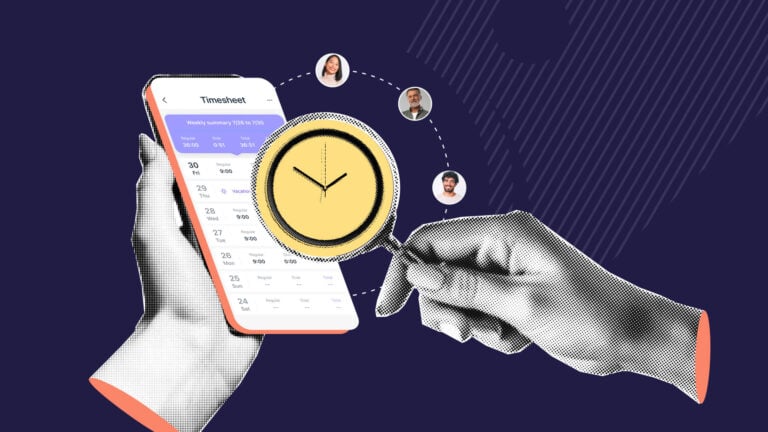Payroll errors, time theft, and messy approvals are common when employees track hours manually. For businesses with field teams, the costs add up fast.
A mobile timesheet app replaces paper logs and spreadsheets with accurate, real-time data. Employees can clock in from their phones, managers get instant oversight, and payroll becomes faster and more reliable.
This guide compares the five best mobile timesheet apps for 2025, based on real testing across industries like construction, healthcare, security, and cleaning. Each app is reviewed for usability, features, and value, so you can pick the right one and get back to running your business.
Our Top Picks
-
Best all-in-one timesheet app
-
Good for reducing time theft
-
Good for teams with onsite and field employees
Why trust us?
Our team of unbiased software reviewers follows strict editorial guidelines, and our methodology is clear and open to everyone.
See our complete methodology
17
Tools considered
10
Tools reviewed
5
Best tools chosen
How I Chose the Best Mobile Timesheet Apps
To create this list, I evaluated dozens of time tracking apps designed for teams on the move. My focus was on tools that solve real problems for businesses with mobile, hourly, or field-based workers. That means better accuracy, fewer payroll mistakes, and less time wasted chasing down approvals or fixing errors.
I looked for three things: reliable core functionality, ease of use in the field, and extra features that make daily operations smoother.
Core Time Tracking Features
These are the non-negotiables. If an app didn’t do these well, it didn’t make the list.
- Mobile clock-ins and task tracking: Employees should be able to clock in and out from their phones, select a job or client, and switch tasks easily during the day. This is essential for teams working in the field or across multiple job sites.
- GPS location tracking and geofencing: I prioritized apps that let you verify where your team is when they clock in. Geofencing adds another layer of accuracy by preventing off-site punches.
- Break, overtime, and PTO automation: These features help businesses stay compliant and avoid disputes. I looked for apps that calculate these automatically based on your rules or regional labor laws.
- Clock-in restrictions: Tools like facial recognition, IP filters, and auto clock-outs help prevent time theft and accidental over-reporting.
- Timesheet approval workflows: Managers need a fast way to review, comment on, and approve timesheets. I favored apps that support customizable approvals and real-time notifications.
Ease of Use in the Field
Even the most powerful features fall flat if the app is clunky or hard to learn.
- Simple, intuitive mobile experience: Field employees shouldn’t need training to track their time. I gave extra points to apps with clean, easy-to-use interfaces that work just as well on a job site as in an office.
- Quick setup and admin controls: I looked for platforms that are easy to roll out across a team and offer flexible controls for different job roles, sites, or departments.
Bonus Features That Save Time
Beyond the basics, I considered extra tools that save managers time and give businesses better visibility into operations.
- Payroll integrations: Syncing with tools like QuickBooks, Gusto, ADP, or Paychex means fewer errors and faster processing. I tested how easy it was to export or automate payroll directly from the timesheet data.
- Customizable reports: The ability to break down hours by project, task, or client helps business owners see where time and money are going—and where they might be leaking.
These criteria reflect the challenges I’ve seen firsthand in industries like construction, healthcare, cleaning, security, and logistics. If your teams don’t work behind desks, you need a mobile timesheet solution that just works.
The 5 Best Mobile Timesheet Apps of 2025
-
Connecteam — Best all-in-one timesheet app
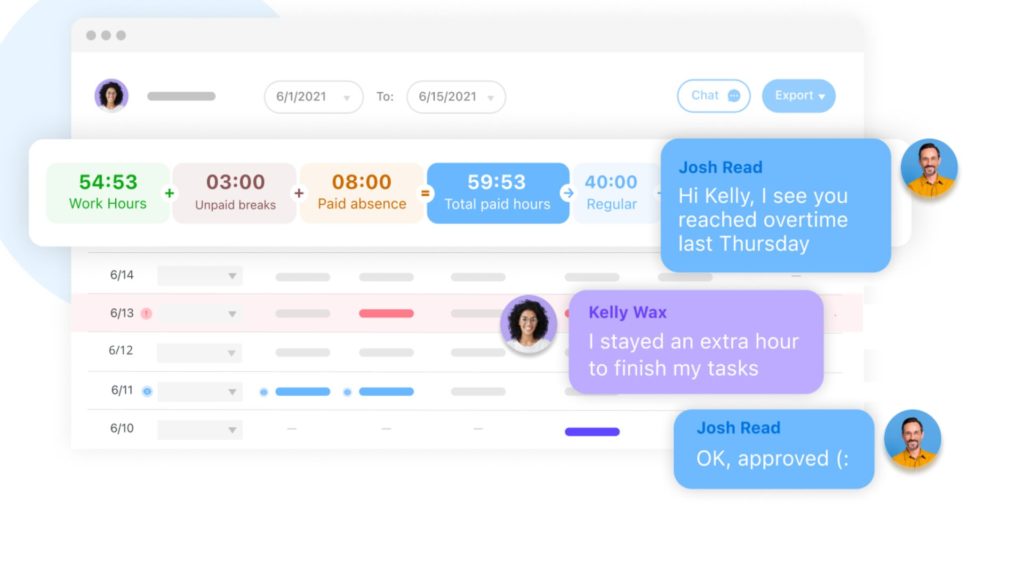
Connecteam is the best mobile timesheet app for businesses with deskless workforces. I found it useful for industries like retail, manufacturing, healthcare, and others where teams are always in the field or on the move.
Why I chose Connecteam: Connecteam tops my list because it’s affordable, easy to use, and feature-rich. Its intuitive Android and iOS apps let deskless employees track hours, anytime, anywhere. The biggest perk is that Connecteam’s premium features are completely free for small businesses with up to 10 employees.
Let’s take a closer look at the key timesheet tools Connecteam offers:
Automated time tracking
Connecteam automates time tracking and timesheet management processes, leaving no room for costly errors. Tracking time takes a single tap of a button on the intuitive Android and iOS apps. The user-friendliness makes it incredibly easy for employees, including non-techies in your workforce, to record work hours with precision.
Moreover, Connecteam clock-in restrictions and reminders ensure you pay employees for the time they actually worked. You can set up a geofence to curb off-site punching, use auto-clock-out to prevent timesheet padding, and restrict employees to clocking in only for their assigned shifts. In addition, you can configure reminders to ensure no employees forget to track time or breaks.
These features enhance timesheet accuracy, which is beneficial for both the employee and your company. They promote fair payment, which in turn boosts employee morale and prevents your business from bleeding money through time theft.
Customizable timesheet approval
Once an employee clocks out, Connecteam automatically creates the daily timesheet. You can lock the daily timesheets to prevent employees from making further edits. However, you can also let employees edit timesheets to add missed breaks and shifts. In this case, you can set the edited timesheets to get admin approval to promote accountability.
At the end of the pay period, Connecteam compiles daily timesheets into one payroll-ready timesheet. However, to promote accuracy, you can require employees to review their timesheet once more. I really like the timesheet reminders, which prompt employees to review and submit timesheets on time.
Another thing I love is that Connecteam allows you to delegate timesheet approval duties to various managers. Managers can leave comments directly on an employee’s timesheet if they have a question about their time entries. Alternatively, they can use the built-in chat feature to communicate directly with employees when they need faster resolution.
Run payroll in minutes
With verified timesheet data, paying employees is a matter of a few clicks. Connecteam prepares a detailed payroll report, showing a breakdown of employee earnings from total work hours, total paid breaks, total overtime, and total pay.
You can easily export timesheet data from Connecteam for use with almost any major payroll software. Better yet, Connecteam offers integrations with RUN Powered by ADP®, Gusto, QuickBooks Online, Paychex, and Xero to make payroll processing even simpler.
And so much more
Connecteam offers an array of other helpful features, including:
- Employee scheduling: Connecteam lets you create employee schedules using an intuitive drag-and-drop timeline. You can also use the auto-scheduler to speed up the scheduling process and sidestep potential conflict issues.
- Time-off management: You can set custom time off rules, allow employees to request paid or unpaid time off, and instantly review and approve requests from anywhere. Better yet, Connecteam lets you instantly review and approve time off requests from anywhere.
- Break and overtime tracking: Connecteam allows you to set up automatic and manual break policies. You can also configure and enforce overtime rules based on regional labor laws.
- Job rate customization: Connecteam allows you to set custom rates for each project or task. This simplifies remuneration, ensuring each employee is paid based on the specific tasks they have completed.
Key Features
- One-tap mobile clock-in
- GPS tracking and geofencing
- Auto clock-out and shift rules
- Timesheet approvals with manager controls
- Payroll integrations
- Drag-and-drop scheduling
Pros
- Easy to use on any mobile device
- Prevents time theft with location tools
- Streamlines payroll with integrations
- Includes built-in scheduling and PTO tracking
Cons
- Needs internet access
Pricing
Free-for-life plan availablePremium plans start at $29/month for 30 users
14-day free trial, no credit card required
Start your free trial -
Buddy Punch — Good for reducing time theft
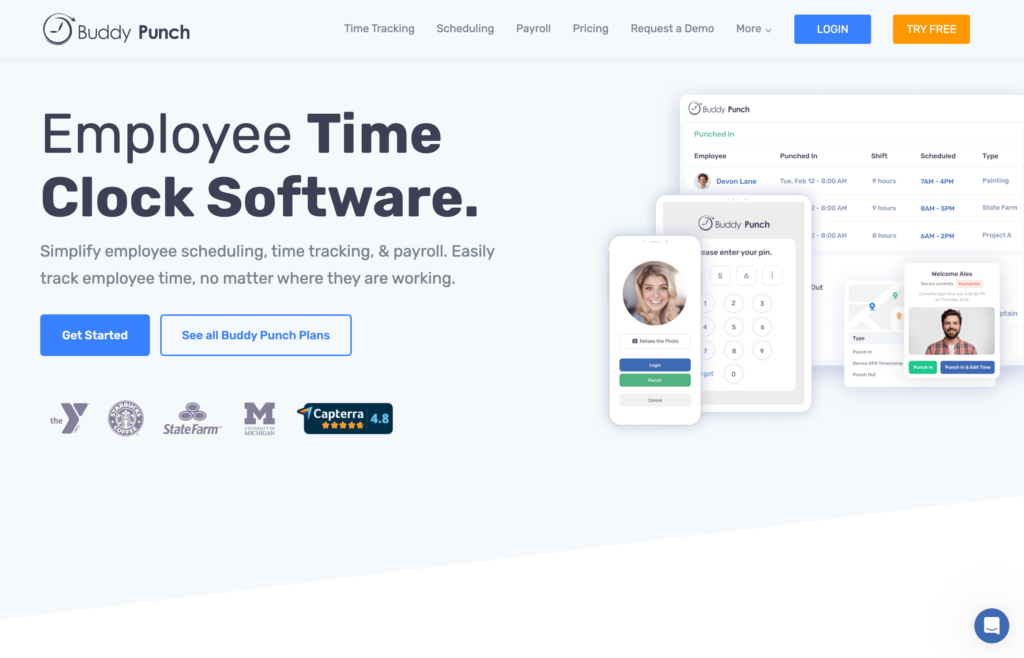
Buddy Punch is a reliable mobile timesheet app for businesses in the construction, cleaning, and field service industries.
Why I chose Buddy Punch: Buddy Punch’s ability to thwart time theft through geofencing and webcam tools impressed me the most. These features, together with automated timesheets and payroll integrations, earned the software second place on my list. However, it lacks an offline mode, which can be somewhat off-putting for teams in low-connectivity regions.
Let’s explore Buddy Punch’s key timesheet features:
Geofencing and webcam
Buddy Punch comes to its element when used to thwart various forms of time theft within a work site. I liked its flexible geofence, which enables business owners to erect virtual boundaries around work sites. The geofences ensure employees clock in or out only when they’re physically present at the assigned work site.
Additionally, Buddy Punch provides a webcam tool to prevent buddy punching. The webcam requires employees to take a selfie photo at clock-in. However, the manager has to verify employee identity manually during timesheet review to pinpoint buddy punchers.
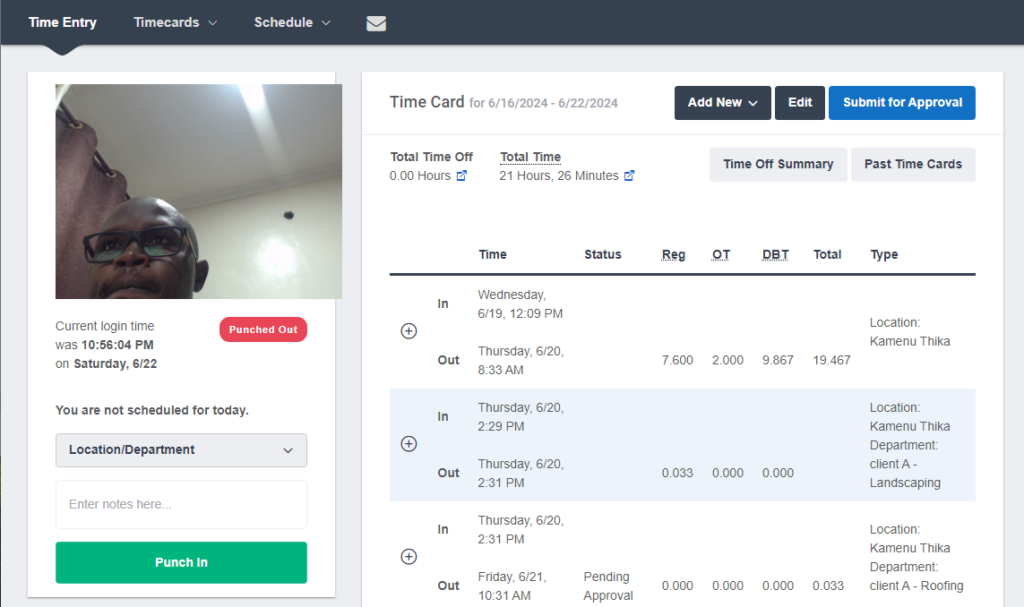
Buddy Punch allows employees to clock in/out on any desktop device with a webcam. Lastly, the facial recognition feature leverages Apple’s Face ID to authenticate employees’ identity at log-in (not clock-in). I found this unconventional method less effective at thwarting buddy-punching. Moreover, it’s only available for iOS smartphone users; a real deal-breaker for Android users.
Accurate break and overtime tracking
Buddy Punch also proved quite effective for break and overtime tracking. I liked the flexibility to configure break-tracking policies to conform to the underlying labor laws. The only minor flaw is that the app doesn’t remind employees to start their manual breaks, which can lead to missed or unrecorded breaks.
Moreover, Buddy Punch allows you to track any type of overtime. I set the app to track overtime based on California overtime law and it worked just fine. What stood out to me is that Buddy Punch sorted the overtime hours accurately and calculated overtime pay automatically to speed up the payroll process.
What users say about Buddy Punch:
Super user-friendly! Very Easy to use. It has various options for employees that can be utilized. Great App!
Sometimes it doesn’t fully log me out and I have to go in a change my log-out time, which can be frustrating especially if I don’t remember my exact time of leaving work as my schedule is flexible. Great App!
Key Features
- GPS tracking with geofencing
- Photo capture at clock-in
- Manual break and overtime tracking
- Payroll integrations with QuickBooks, Gusto, and more
Pros
- Strong tools to prevent time theft
- Easy-to-review digital timesheets
Cons
- No offline mode
- Facial recognition only works on iOS
Pricing
Starts at $3.99/user/month + $19 base fee/month Trial: Yes — 14-day Free Plan: No
-
Clockify — Good for teams with onsite and field employees
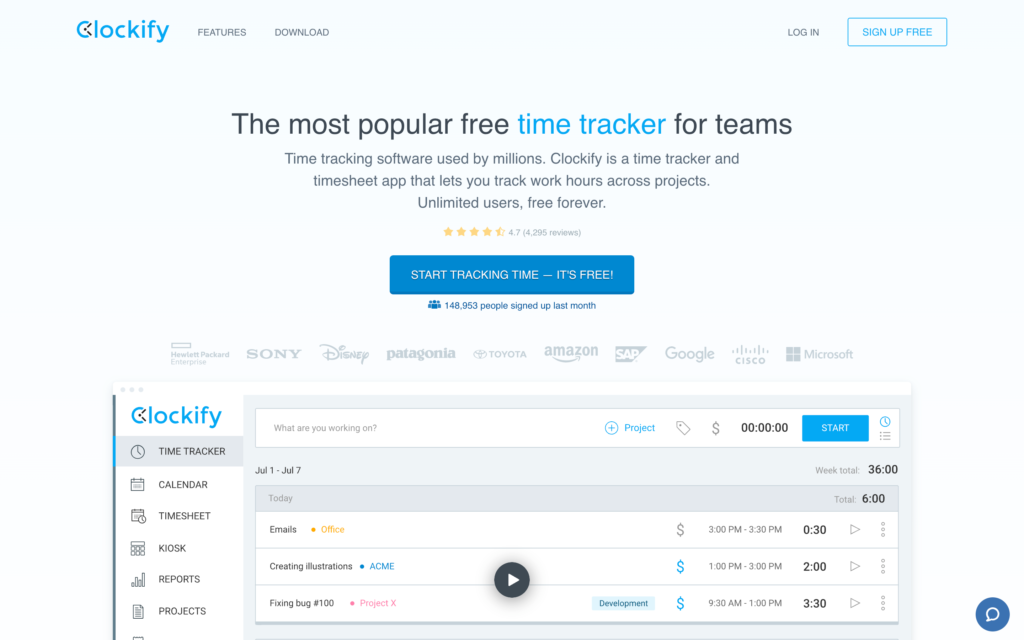
Clockify is a reliable time tracking app ideal for on-site and field teams, thanks to its flexible tracking options.
Why I chose Clockify: Clockify made it onto this list because of its generous free version, which supports unlimited users. I also liked its offline mode and flexible tracking options, which make it ideal for both office-based and field teams. I would’ve ranked Clockify higher on my list were it not for its dated interface and limited workforce management features.
Flexible time tracking options
Clockify’s multiple tracking modes — timer-based, manual, and timesheet — make it suitable for a variety of work environments. The timer-based mode lets employees start and stop a timer to create timesheets without hassle on desktop or mobile apps. This eliminates the guesswork, ensuring each timesheet reflects time spent on actual tasks.
Teams with predictable schedules or those working in structured environments can utilize the timesheet or manual modes. However, I recommend using the manual modes only if you have a strict timesheet approval process to maintain granular control. Thankfully, Clockify supports project-specific approval, letting managers verify entries for their own projects.
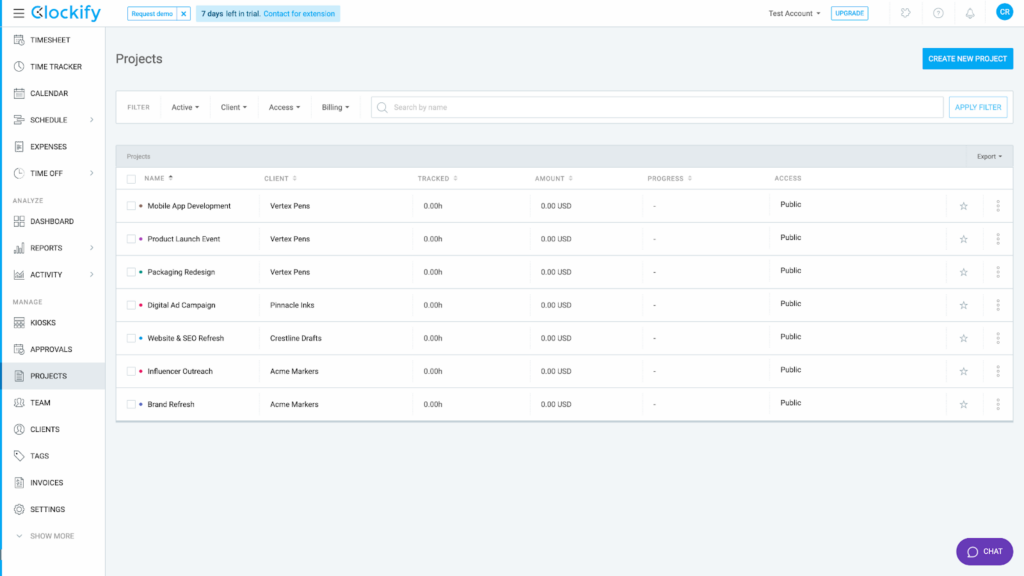
There are lots of filters but few other ways of visually organizing information. Rather than clicking once to expand a given client and see associated projects, you have to filter by each one individually. Clockify also includes an auto-tracker, perfect for professionals who switch between tasks and often forget to start the timer. The tracker runs in the background and suggests time entries based on apps or URLs an employee uses. Doing so makes it easy to recall the time spent on each task, boosting time card accuracy.
Offline tracking
Thanks to its strong offline mode, Clockify enables employees to track time without an internet connection. It ensures continuous and error-free time tracking even when field and mobile teams traverse areas with poor or no internet connection.
The mobile app stores the time records locally and syncs them automatically once the employee’s device is reconnected. This prevents missed time entries and the frustrating back-and-forth often needed to fix errors at the end of the pay period.
While the time clock works flawlessly without an internet connection, certain features remain unusable. For example, employees can’t access specific project details, whereas managers can’t generate time reports without an internet connection. Some users have also reported issues with data syncing, which can cause potential discrepancies in time logs. Luckily, I didn’t encounter this issue during my testing.
What users say about Clockify:
Clockify allowed me to track time across several projects. I was able to easily switch between tasks without forgetting or the detailed reports that told me where my work hours went each week.
It is sluggish and slow. Every time I make a change, I have to wait several seconds. The reports are really barebones and not that useful.
Key Features
- Multiple time tracking modes (timer, manual, timesheet)
- Offline time tracking
- Auto tracker for desktop activity
- Project- and task-based reporting
Pros
- Free plan with unlimited users
- Works well for both office and field teams
Cons
- Dated interface
- Limited workforce management features
Pricing
Starts at $3.99/user/month Trial: Yes — 7 days Free Plan: Yes
-

QuickBooks Time — Good for businesses that already use QuickBooks

QuickBooks Time (formerly TSheets) is a reliable time tracking app that offers features tailored for field and mobile teams. It’s particularly useful for businesses that already use QuickBooks for accounting and payroll.
Why I chose QuickBooks Time: QuickBooks Time packs the punch when it comes to time-tracking and workforce management features. It has the features you need to track employee hours accurately, including geofencing and offline tracking. However, QuickBooks Time is comparatively pricey, and the admin app is glitchy, which is why it ranks fourth.
Let’s take a closer look at QuickBooks Time’s key features:
Strong offline mode
Like Clockify, QuickBooks Time enables employees to track time even without an internet connection. This is particularly beneficial for field and mobile teams that traverse regions with low connectivity or outside the cellular range. The offline mode minimizes missed time entries to maintain accurate time records.
QuickBooks Time stores offline data locally and syncs it to the cloud once the device is reconnected to the internet. Most of the time, the app synced data automatically, but there were a few times when it failed to do so, even when the internet connection was stable.
Customizable time approval
QuickBooks Time supports automatic time tracking to enhance timesheet accuracy. It also utilizes clock-in restrictions, geofencing, and photo capture to cut out potential errors and time theft. This ensures each timesheet is error-free and payroll-ready.
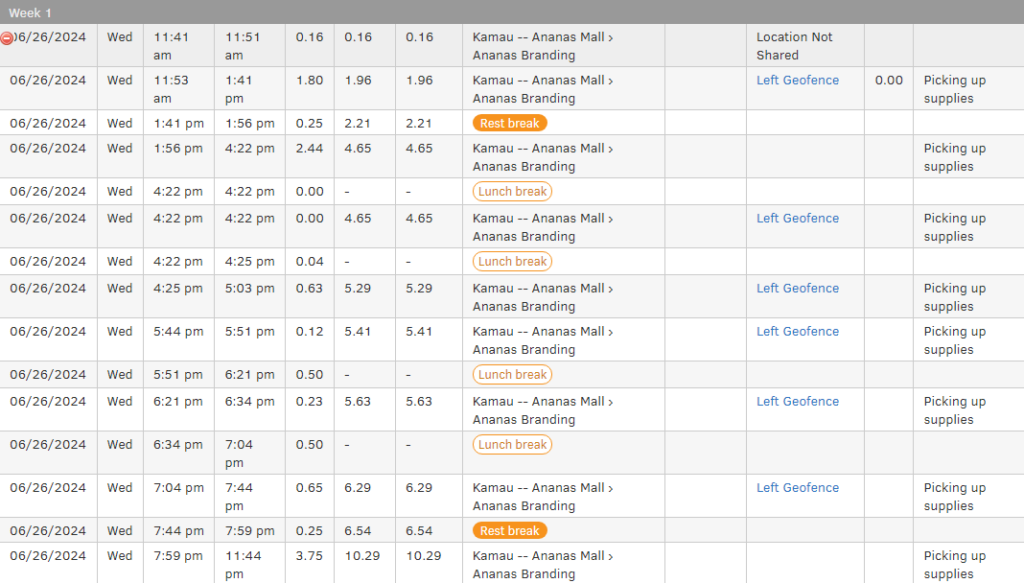
QuickBooks Time shows when the employee attempted to clock in outside their job site. Nonetheless, I think it’s good to have managers review timesheets to catch errors that might have slipped through the cracks. The good thing is that QuickBooks Time automates timesheet approval to streamline payroll processing. It submits timesheets automatically and notifies managers via email to eliminate potential delays.
It also locks approved timesheets, preventing employees from making further edits. At this point, timesheets are payroll-ready and can be used to generate wage reports. I’m glad that QuickBooks Time integrates seamlessly with QuickBooks Online to speed up remuneration. You can also export the reports to other accounting software like Xero, Square, Gusto, or Paychex.
What users say about QuickBooks Time:
Quickbooks time allows me to send reminders to my staff to clock in, if they are not clocked in at the start of their shift.
Functions well for small businesses managing employee timecards, but lacks the robust features needed by accounting or law firms that bill clients based on time
Key Features
- Mobile clock-in with GPS tracking
- Geofencing for location-based reminders
- Automated timesheet approvals
- Seamless integration with QuickBooks Online
Pros
- Strong fit for businesses already using QuickBooks
- Tracks time accurately even without internet
Cons
- Higher price than most competitors
- Admin app can be buggy at times
Pricing
Starts at $20/month + $10/user/month Trial: Yes — 30-day Free Plan: No
-

Hubstaff — Good for desktop activity monitoring
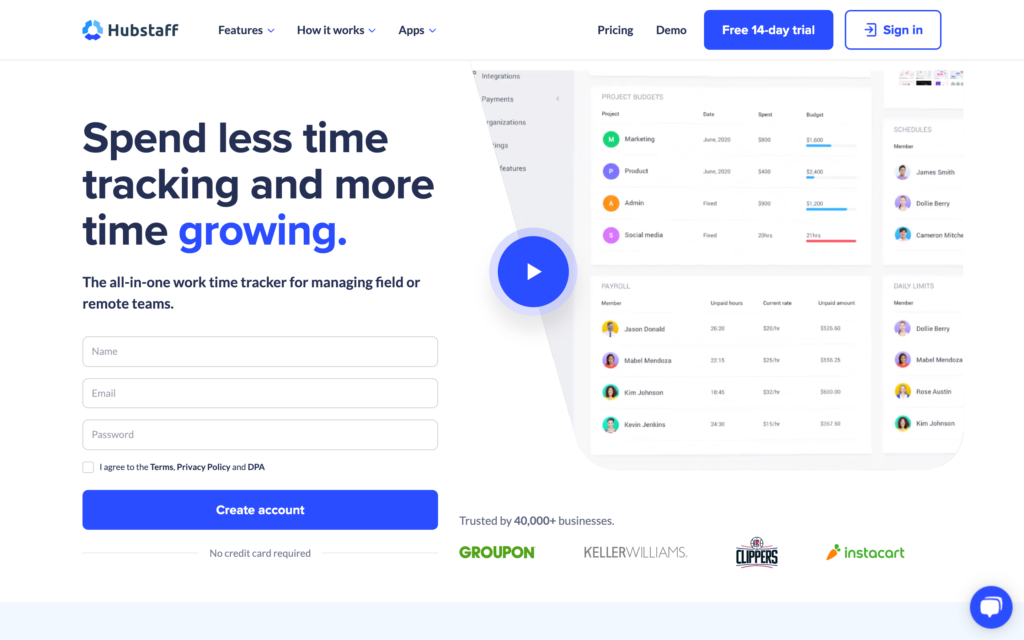
Hubstaff is a user-friendly time-tracking and employee monitoring software for deskless, office-based, and hybrid teams.
Why I chose Hubstaff: Although Hubstaff offers time-tracking features for various work environments, I believe it’s better suited for office-based teams. I chose it mainly because of its activity monitoring tool, which provides insights into what goes on during an employee’s workday. However, its time-tracking suite lacks advanced features, which is why it came in last on my list.
Time tracking with activity monitoring
Hubstaff is undoubtedly one of the more powerful time tracking apps on the market. Its time tracker works seamlessly across various platforms, including Windows, macOS, Linux, Android, iOS, and Chrome. This compatibility enables employees to track time on any device.
The standout feature is activity monitoring, which monitors employee desktop activity in the background. It takes periodic screenshots, captures mouse and keyboard activity levels, and logs applications and URLs accessed. The records enable managers to uncover active work periods and monitor employee productivity during work hours.
Keep in mind that Hubstaff monitors desktop activities only when an employee is clocked in. This guarantees that it doesn’t engage in invasive monitoring, alleviating any fears employees might have regarding their privacy. That said, the feature is limited to desktop devices and is mainly helpful for office-based employees.

The Hubstaff web app timer allows office-based teams to track time with ease. Geofenced tracking
Hubstaff has a geofence tool, which is mainly helpful for tracking billable hours. Ordinarily, many time tracking apps use geofencing to restrict clock-ins to designated work sites. This prevents off-site punching, boosting timesheet accuracy.
However, Hubstaff treads a different path and isn’t designed to restrict clock-ins. Actually, I was able to clock in and out even when outside the geofence. The feature is only meant to start the timer automatically when an employee enters a geofenced area and clock them out as they leave.
This helps determine the time spent at a specific location. I found it helpful for sales representatives, field service companies, and other businesses that want to track billable hours. You can also set Hubstaff to notify you immediately when an employee enters or leaves the geofence.
What users say about Hubstaff:
I like their time tracking features and the ability to view employee usage. Also, their payment integrations are helpful.
Its interface is not very appealing, with many widgets spread across sections that use too much space of the screen.
Key Features
- Time tracking with desktop activity monitoring
- GPS tracking and geofenced auto clock-ins
- Project and task management
- Payroll and invoicing integrations
Pros
- Great for tracking productivity on desktop
- Useful for billing hours by location or project
Cons
- Activity monitoring is desktop-only
- Many advanced features locked behind higher-tier plans
Pricing
Starts at $4.99/user/month, 2 users minimum Trial: Yes — 14-day Free Plan: Yes — For one user only
Compare the Best Mobile Timesheet Apps
| Topic |
 Start for free
Start for free
|
|
|

|

|
|---|---|---|---|---|---|
| Reviews |
4.8
|
4.8
|
4.8
|
4.7
|
4.6
|
| Pricing |
Starts at just $29/month for the first 30 users
|
Starts at $3.99/user/month + $19 base fee/month
|
Starts at $3.99/user/month
|
Starts at $20/month + $10/user/month
|
Starts at $4.99/user/month, 2 users minimum
|
| Free Trial |
yes
14-day
|
yes
14-day
|
yes
7 days
|
yes
30-day
|
yes
14-day
|
| Free Plan |
yes
Free Up to 10 users
|
no
|
yes
|
no
|
yes
For one user only
|
| Use cases |
Best all-in-one timesheet app
|
Good for reducing time theft
|
Good for teams with onsite and field employees
|
Good for businesses that already use QuickBooks
|
Good for desktop activity monitoring
|
| Available on |
What are Timesheet Apps?
Timesheet apps are digital tools that businesses use to keep track of the hours their employees work. These apps typically replace traditional paper timesheets. They allow workers to clock in and out through a digital interface.
In particular, mobile timesheet apps let employees punch in and out right from their mobile devices. Employees can track their work hours and categorize time entries by task, client, or project.
Timesheet apps automatically generate timesheets that include all the hours an employee worked during a pay period. Timesheets typically list time by day or week, but they can also list time by project or pay rate.
Managers can review and approve timesheets, then export them for payroll processing. This ensures employees are paid accurately and on time.
Overall, timesheet apps provide greater accuracy, efficiency, and convenience in managing employees’ time.
How do Mobile Timesheet Apps Work?
Mobile timesheet apps allow employees to create time entries by clocking in and out right from their phone. These systems usually also let employees create time entries manually if they forget to clock in or out.
The apps generate digital timesheets for each employee that include all the hours they worked during a pay period. Employees can create and edit time entries manually, or managers can do it for their staff. Managers then check and approve employees’ timesheets and send them off for payroll.
The majority of these apps also automatically track overtime and offer break management features to help businesses stay compliant. Some have direct payroll integrations for easy processing, as well as built-in scheduling tools for stress-free planning.
The Benefits of Mobile Timesheet Apps
Timesheet apps offer a number of benefits, including:
- Time savings. Employees can clock in and out with just a touch, saving time that would otherwise be spent manually recording time. Mobile time managers also automatically generate timesheets and remind employees and managers to approve them. This ensures that payroll isn’t delayed because of a forgotten approval.
- Reduced errors and costs. Employees can accurately track their time, sometimes down to the second, using a timesheet app. These systems often have features that flag timesheet irregularities and allow managers and employees to edit timesheets to ensure they’re correct. With accurate timesheets, there’s far less risk of costly payroll errors. Timesheet apps also automate administrative tasks, thus reducing administrative costs.
- Improved compliance. With a timesheet app, you can remind employees to take mandated breaks and automatically calculate break and overtime payments. This way, your business stays compliant with labor laws and regulations.
- Increased productivity. With these apps, you can export timesheet data in seconds and get back to doing more important work. Employees also won’t be tied up in manually tracking time, so they can be more productive elsewhere.
- Greater insight into business operations. These apps usually have reporting tools that let you see how employees are spending their time and whether they’re being as productive as possible. You can also see how much money you’re spending on PTO, overtime, and certain clients or projects. This data will help you make better, more informed business decisions.
How Much do Timesheet Apps Cost?
Timesheet apps typically charge a flat per-user rate. Some companies also include a base rate, which you’ll pay no matter how many employees your business has. For example, Buddy Punch costs $19 per month plus $3.49 per employee per month. For most timesheet apps, a small business with 20 employees should expect to pay around $100-$200 per month.
Connecteam provides much better value for money compared to other timesheet apps. It offers a free plan for businesses with 10 or fewer employees. Businesses with up to 30 employees will pay only $29 per month. That’s less than $1 per employee per month. You can even add additional users for just $0.50 per month each.
FAQs
Yes, and Connecteam is the best free timesheet app! Businesses with 10 or fewer employees can use Connecteam free for life. There are other free timesheet apps, but they lack features like location tracking, break management, or payroll integrations.
The best way to track employee hours is using time tracking software, like Connecteam’s. Connecteam enables employees to clock in and out with a single touch of their mobile device. Employees can assign time entries to specific projects and receive reminders to clock in and out.
It’s possible to create timesheets in Excel, but it’s typically not a good idea to do so. It’s easy to make a mistake when manually entering time data into Excel, which can lead to underpaying or overpaying employees. You’ll save time and get more accurate timesheets by using a dedicated time tracker like Connecteam.
The Bottom Line On Mobile Timesheet App
Mobile timesheet apps make it easy for employees to accurately track their hours wherever and whenever they work. This is critical to ensure employees are paid correctly. Additionally, timesheet apps make it easier to reduce time theft and keep your business compliant.
Connecteam stands out as the best all-in-one timesheet app. It offers one-touch clock-in and clock-out, automatic timesheet generation, powerful overtime and break management features, and so much more.
Plus, Connecteam is free for small businesses with up to 10 employees. Its paid plans start at just $29 per month for up to 30 users. You can try out Connecteam free for 14 days to see how it can help your business keep track of employees’ time.


